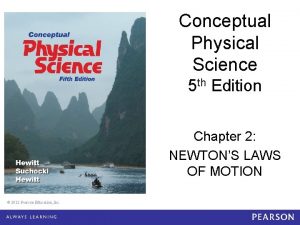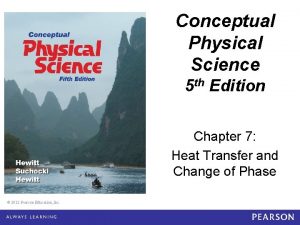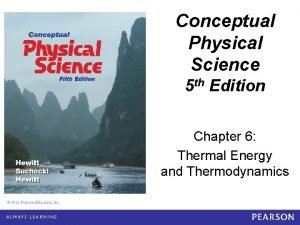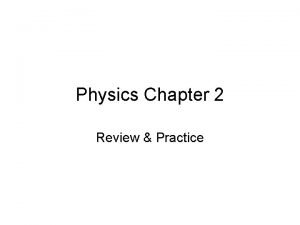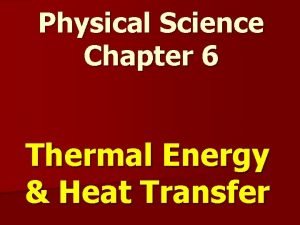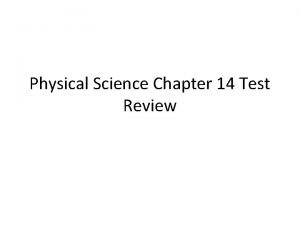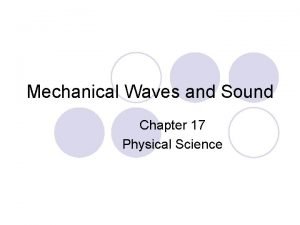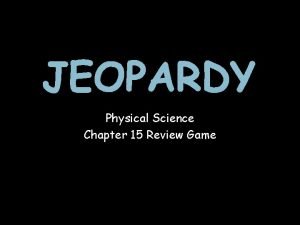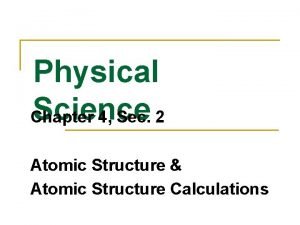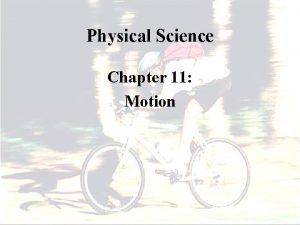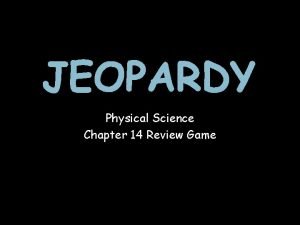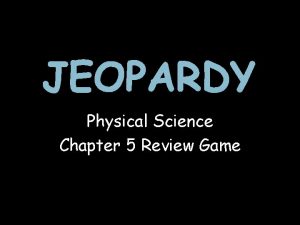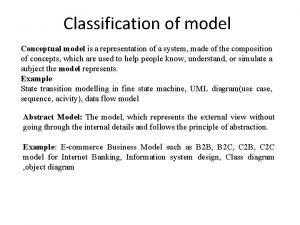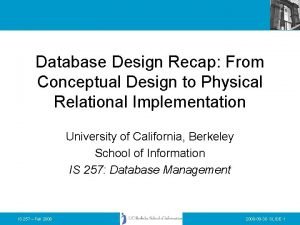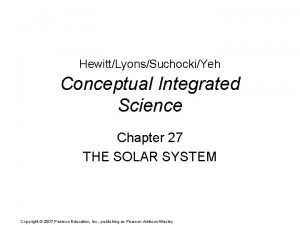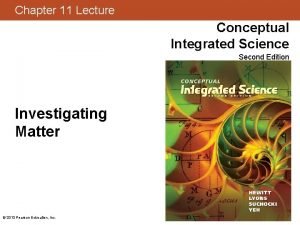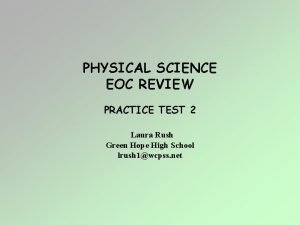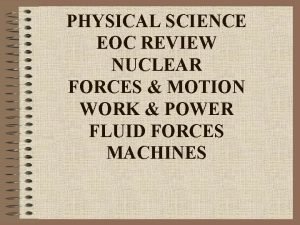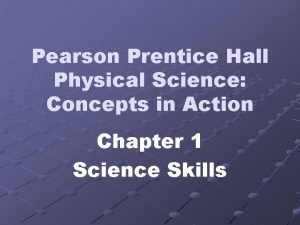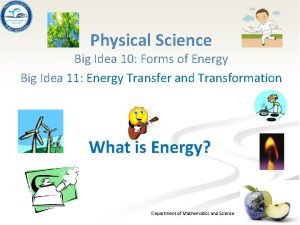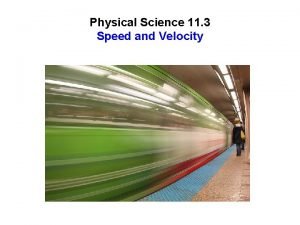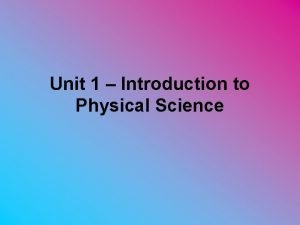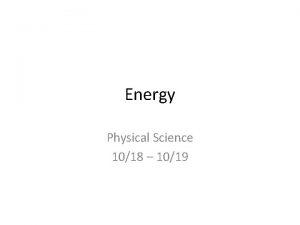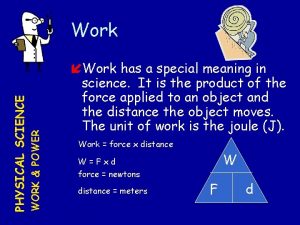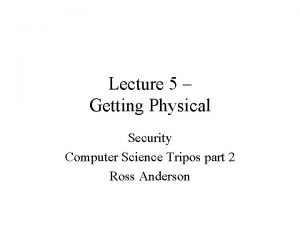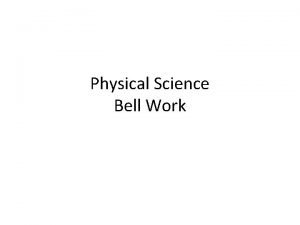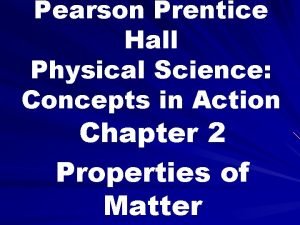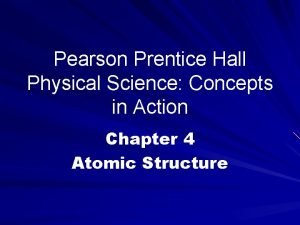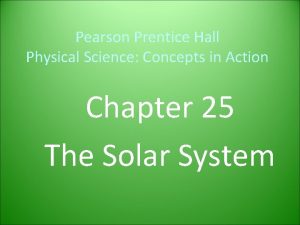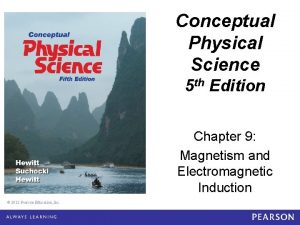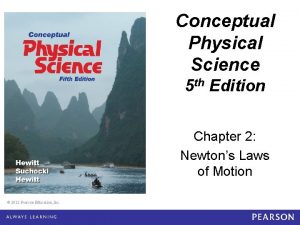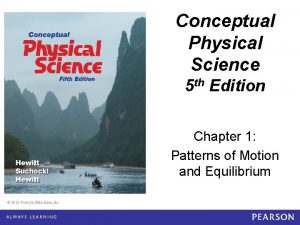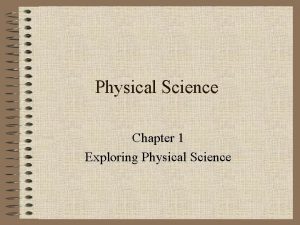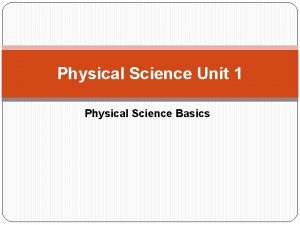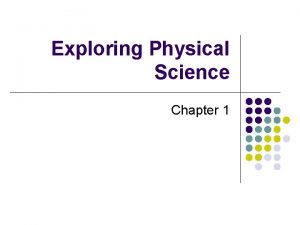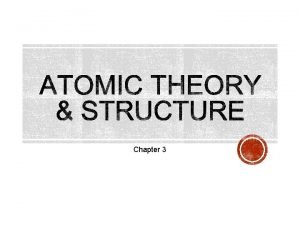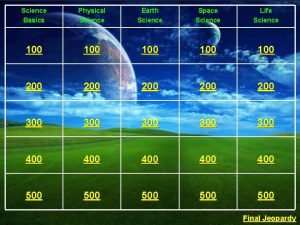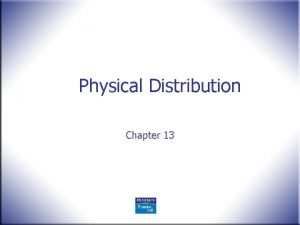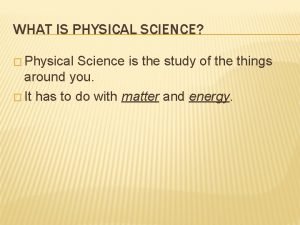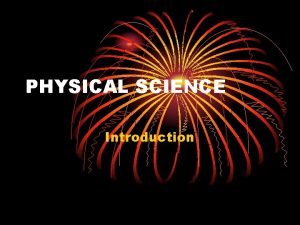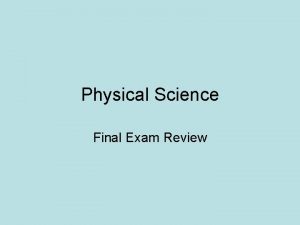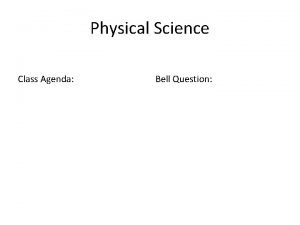Conceptual Physical Science 5 e Chapter 8 Conceptual





























































- Slides: 61

Conceptual Physical Science 5 e — Chapter 8 Conceptual Physical Science 5 th Edition Chapter 8: Static and Current Electricity © 2012 Pearson Education, Inc.

Conceptual Physical Science 5 e — Chapter 8 Which of these particles has an electrical charge? A. B. C. D. Proton. Electron. Ion. All of the above. © 2012 Pearson Education, Inc.

Conceptual Physical Science 5 e — Chapter 8 Which of these particles has an electrical charge? A. B. C. D. Proton. Electron. Ion. All of the above. Explanation: An ion, by definition, is a charged atom—one with an extra electron(s) or deficient in one or more electrons. © 2012 Pearson Education, Inc.

Conceptual Physical Science 5 e — Chapter 8 Which is the predominant carrier of charge in copper wire? A. B. C. D. Proton. Electron. Ion. All of the above. © 2012 Pearson Education, Inc.

Conceptual Physical Science 5 e — Chapter 8 Which is the predominant carrier of charge in copper wire? A. B. C. D. Proton. Electron. Ion. All of the above. © 2012 Pearson Education, Inc.

Conceptual Physical Science 5 e — Chapter 8 If a neutral atom has 22 protons in its nucleus, the number of surrounding electrons is A. B. C. D. less than 22. more than 22. sometimes all of the above in a neutral atom. © 2012 Pearson Education, Inc.

Conceptual Physical Science 5 e — Chapter 8 If a neutral atom has 22 protons in its nucleus, the number of surrounding electrons is A. B. C. D. less than 22. more than 22. sometimes all of the above in a neutral atom. © 2012 Pearson Education, Inc.

Conceptual Physical Science 5 e — Chapter 8 When we say charge is conserved, we mean that charge can A. B. C. D. be saved, like money in a bank. only be transferred from one place to another. take equivalent forms. be created or destroyed, as in nuclear reactions. © 2012 Pearson Education, Inc.

Conceptual Physical Science 5 e — Chapter 8 When we say charge is conserved, we mean that charge can A. B. C. D. be saved, like money in a bank. only be transferred from one place to another. take equivalent forms. be created or destroyed, as in nuclear reactions. Explanation: Electric charge cannot be created or destroyed. It can only be transferred. © 2012 Pearson Education, Inc.

Conceptual Physical Science 5 e — Chapter 8 Which of these rules is basic to all of physics? A. B. C. D. The conservation of energy. The conservation of momentum. The conservation of charge. All of the above. © 2012 Pearson Education, Inc.

Conceptual Physical Science 5 e — Chapter 8 Which of these rules is basic to all of physics? A. B. C. D. The conservation of energy. The conservation of momentum. The conservation of charge. All of the above. © 2012 Pearson Education, Inc.

Conceptual Physical Science 5 e — Chapter 8 According to Coulomb’s law, doubling both charges of a pair of particles will result in a force between them that is A. B. C. D. twice as strong. four times as strong. half as strong. one-quarter as strong. © 2012 Pearson Education, Inc.

Conceptual Physical Science 5 e — Chapter 8 According to Coulomb’s law, doubling both charges of a pair of particles will result in a force between them that is A. B. C. D. twice as strong. four times as strong. half as strong. one-quarter as strong. © 2012 Pearson Education, Inc.

Conceptual Physical Science 5 e — Chapter 8 According to Coulomb’s law, a pair of particles that are placed twice as close to each other will experience forces that are A. B. C. D. twice as strong. four times as strong. half as strong. one-quarter as strong. © 2012 Pearson Education, Inc.

Conceptual Physical Science 5 e — Chapter 8 According to Coulomb’s law, a pair of particles that are placed twice as close to each other will experience forces that are A. B. C. D. twice as strong. four times as strong. half as strong. one-quarter as strong. Explanation: Coulomb’s law is an inverse-square law—for closeness as well as increased distance. © 2012 Pearson Education, Inc.

Conceptual Physical Science 5 e — Chapter 8 When a negatively charged balloon is placed against a nonconducting wall, negative charges in the wall are A. B. C. D. attracted to the balloon. repelled from the balloon. too bound to positive charges in the wall to have any effect. neutralized. © 2012 Pearson Education, Inc.

Conceptual Physical Science 5 e — Chapter 8 When a negatively charged balloon is placed against a nonconducting wall, negative charges in the wall are A. B. C. D. attracted to the balloon. repelled from the balloon. too bound to positive charges in the wall to have any effect. neutralized. Explanation: The negative balloon repels negative charge in the wall and attracts positive charge. Charges of atoms and molecules are therefore nudged apart. This condition of charge separation is called polarization. © 2012 Pearson Education, Inc.

Conceptual Physical Science 5 e — Chapter 8 When you brush your hair and scrape electrons from your hair, the charge of your hair is A. B. C. D. positive. negative. Both of these. Neither of these. © 2012 Pearson Education, Inc.

Conceptual Physical Science 5 e — Chapter 8 When you brush your hair and scrape electrons from your hair, the charge of your hair is A. B. C. D. positive. negative. Both of these. Neither of these. Comment: And if electrons were scraped off the brush onto your hair, your hair would have a negative charge. © 2012 Pearson Education, Inc.

Conceptual Physical Science 5 e — Chapter 8 The strength of an electric field is measured by the force A. B. C. D. exerted on a charged particle in the field. between electric field lines. between oppositely charged parallel plates. All of the above. © 2012 Pearson Education, Inc.

Conceptual Physical Science 5 e — Chapter 8 The strength of an electric field is measured by the force A. B. C. D. exerted on a charged particle in the field. between electric field lines. between oppositely charged parallel plates. All of the above. © 2012 Pearson Education, Inc.

Conceptual Physical Science 5 e — Chapter 8 The direction of an electric field, by convention, is the direction of force that the field would exert on A. B. C. D. an electron. a proton. an atom. All of the above. © 2012 Pearson Education, Inc.

Conceptual Physical Science 5 e — Chapter 8 The direction of an electric field, by convention, is the direction of force that the field would exert on A. B. C. D. an electron. a proton. an atom. All of the above. © 2012 Pearson Education, Inc.

Conceptual Physical Science 5 e — Chapter 8 When you do work on an electrically charged particle, you change the particle’s A. B. C. D. charge. potential energy. capacitance. power. © 2012 Pearson Education, Inc.

Conceptual Physical Science 5 e — Chapter 8 When you do work on an electrically charged particle, you change the particle’s A. B. C. D. charge. potential energy. capacitance. power. Comment: Recall the work–energy theorem in Chapter 3. © 2012 Pearson Education, Inc.

Conceptual Physical Science 5 e — Chapter 8 When you increase the potential energy of a charged particle, you increase its ability to A. B. C. D. do work. charge other particles. conduct. transform to heat. © 2012 Pearson Education, Inc.

Conceptual Physical Science 5 e — Chapter 8 When you increase the potential energy of a charged particle, you increase its ability to A. B. C. D. do work. charge other particles. conduct. transform to heat. Comment: Recall from Chapter 3 that the potential energy acquired by something equals the work done on it. © 2012 Pearson Education, Inc.

Conceptual Physical Science 5 e — Chapter 8 Electric potential, measured in volts, is a ratio of A. B. C. D. charge to the square of the separation distance. current to resistance. energy to charge. power to current. © 2012 Pearson Education, Inc.

Conceptual Physical Science 5 e — Chapter 8 Electric potential, measured in volts, is a ratio of A. B. C. D. charge to the square of the separation distance. current to resistance. energy to charge. power to current. © 2012 Pearson Education, Inc.

Conceptual Physical Science 5 e — Chapter 8 A party balloon may be charged to thousands of volts. The charged balloon isn’t dangerous because it carries relatively little A. B. C. D. current. energy. capacitance. resistance. © 2012 Pearson Education, Inc.

Conceptual Physical Science 5 e — Chapter 8 A party balloon may be charged to thousands of volts. The charged balloon isn’t dangerous because it carries relatively little A. B. C. D. current. energy. capacitance. resistance. © 2012 Pearson Education, Inc.

Conceptual Physical Science 5 e — Chapter 8 A coulomb of charge that passes through a 12 -volt battery is given A. B. C. D. 12 joules. 12 amperes. 12 ohms. 12 watts. © 2012 Pearson Education, Inc.

Conceptual Physical Science 5 e — Chapter 8 A coulomb of charge that passes through a 12 -volt battery is given A. B. C. D. 12 joules. 12 amperes. 12 ohms. 12 watts. Explanation: Voltage = energy/charge; (12 V)/(1 C) = 12 J/C. © 2012 Pearson Education, Inc.

Conceptual Physical Science 5 e — Chapter 8 Which statement is correct? A. B. C. D. Voltage flows in a circuit. Charge flows in a circuit. Current causes voltage. All of the above are correct. © 2012 Pearson Education, Inc.

Conceptual Physical Science 5 e — Chapter 8 Which statement is correct? A. B. C. D. Voltage flows in a circuit. Charge flows in a circuit. Current causes voltage. All of the above are correct. Explanation: Voltage is established across a circuit, not through it. Also, voltage causes current, and not the other way around. © 2012 Pearson Education, Inc.

Conceptual Physical Science 5 e — Chapter 8 The rate at which electrons flow in a wire is measured by A. B. C. D. current. voltage. resistance. energy flow. © 2012 Pearson Education, Inc.

Conceptual Physical Science 5 e — Chapter 8 The rate at which electrons flow in a wire is measured by A. B. C. D. current. voltage. resistance. energy flow. © 2012 Pearson Education, Inc.

Conceptual Physical Science 5 e — Chapter 8 A 10 -ohm resistor carries 10 amperes. The voltage across the resistor is A. B. C. D. zero. more than zero but less than 10 V. more than 10 V. © 2012 Pearson Education, Inc.

Conceptual Physical Science 5 e — Chapter 8 A 10 -ohm resistor carries 10 amperes. The voltage across the resistor is A. B. C. D. zero. more than zero but less than 10 V. more than 10 V. Explanation: The voltage, in accord with Ohm’s law, is 100 V, much greater than 10 V. © 2012 Pearson Education, Inc.

Conceptual Physical Science 5 e — Chapter 8 A 100. 14 resistor is connected to a 120 -volt power supply. The current in the resistor is A. B. C. D. 1 A. 10 A. 120 A. © 2012 Pearson Education, Inc.

Conceptual Physical Science 5 e — Chapter 8 A 10 -ohm resistor is connected to a 120 -volt power supply. The current in the resistor is A. B. C. D. 1 A. 10 A. 120 A. Explanation: By Ohm’s law, current = voltage/resistance = 120 V/10 ohm = 12 A. © 2012 Pearson Education, Inc.

Conceptual Physical Science 5 e — Chapter 8 Electric shock can be so damaging to the human body mainly due to excess A. B. C. D. voltage. current. resistance. None of the above © 2012 Pearson Education, Inc.

Conceptual Physical Science 5 e — Chapter 8 Electric shock can be so damaging to the human body mainly due to excess A. B. C. D. voltage. current. resistance. None of the above. © 2012 Pearson Education, Inc.

Conceptual Physical Science 5 e — Chapter 8 When two identical lamps in a circuit are connected in parallel, the total resistance is A. B. C. D. less than the resistance of either lamp. the same as the resistance of each lamp. less than the resistance of each lamp. None of the above. © 2012 Pearson Education, Inc.

Conceptual Physical Science 5 e — Chapter 8 When two identical lamps in a circuit are connected in parallel, the total resistance is A. B. C. D. less than the resistance of either lamp. the same as the resistance of each lamp. less than the resistance of each lamp. None of the above. Explanation: Resistors in parallel are like extra lines at a checkout counter. More lines means less resistance, allowing for more flow. © 2012 Pearson Education, Inc.

Conceptual Physical Science 5 e — Chapter 8 The equivalent resistance of a pair of identical resistors connected in parallel is A. B. C. D. half the value of either resistor. the same value of either resistor. twice the value of either resistor. Not enough information for an answer. © 2012 Pearson Education, Inc.

Conceptual Physical Science 5 e — Chapter 8 The equivalent resistance of a pair of identical resistors connected in parallel is A. B. C. D. half the value of either resistor. the same value of either resistor. twice the value of either resistor. Not enough information for an answer. Explanation: By the product-over-sum rule, RR/(R + R) = RR/2 R = R/2. © 2012 Pearson Education, Inc.

Conceptual Physical Science 5 e — Chapter 8 The purpose of a safety fuse is to A. B. C. D. provide an additional voltage source. measure the electric power through a circuit. prevent overloading in a circuit. reduce the amount of current in the circuit. © 2012 Pearson Education, Inc.

Conceptual Physical Science 5 e — Chapter 8 The purpose of a safety fuse is to A. B. C. D. provide an additional voltage source. measure the electric power through a circuit. prevent overloading in a circuit. reduce the amount of current in the circuit. © 2012 Pearson Education, Inc.

Conceptual Physical Science 5 e — Chapter 8 A major difference between DC and AC in circuits is the A. B. C. D. voltage associated with each. timing associated with each. way charges flow. way circuits are wired. © 2012 Pearson Education, Inc.

Conceptual Physical Science 5 e — Chapter 8 A major difference between DC and AC in circuits is the A. B. C. D. voltage associated with each. timing associated with each. way charges flow. way circuits are wired. Explanation: In a DC circuit, charge flows in one direction; in AC, charge flows to and fro, alternating direction. © 2012 Pearson Education, Inc.

Conceptual Physical Science 5 e — Chapter 8 What is the rate at which electric energy is converted to another form or transferred to another device? A. B. C. D. Electric power. Electric resistance. AC current. Ohm’s law. © 2012 Pearson Education, Inc.

Conceptual Physical Science 5 e — Chapter 8 What is the rate at which electric energy is converted to another form or transferred to another device? A. B. C. D. Electric power. Electric resistance. AC current. Ohm’s law. © 2012 Pearson Education, Inc.

Conceptual Physical Science 5 e — Chapter 8 How much current is in a 120 -volt line at 1200 watts? A. B. C. D. 6 amperes. 10 amperes. 120 amperes. 240 amperes. © 2012 Pearson Education, Inc.

Conceptual Physical Science 5 e — Chapter 8 How much current is in a 120 -volt line at 1200 watts? A. B. C. D. 6 amperes. 10 amperes. 120 amperes. 240 amperes. Explanation: From power = voltage current, current = power/voltage = 1200 W/120 V = 10 A. © 2012 Pearson Education, Inc.

Conceptual Physical Science 5 e — Chapter 8 A 120 -volt line carries 20 amperes. The power expended is A. B. C. D. 6 watts. 20 watts. 120 watts. 2400 watts. © 2012 Pearson Education, Inc.

Conceptual Physical Science 5 e — Chapter 8 A 120 -volt line carries 20 amperes. The power expended is A. B. C. D. 6 watts. 20 watts. 120 watts. 2400 watts. Explanation: Power = voltage current. © 2012 Pearson Education, Inc.

Conceptual Physical Science 5 e — Chapter 8 How much current is in a 1200 -watt device operating on 20 volts? A. B. C. D. 6 amperes. 10 amperes. 120 amperes. 240 amperes. © 2012 Pearson Education, Inc.

Conceptual Physical Science 5 e — Chapter 8 How much current is in a 1200 -watt device operating on 20 volts? A. B. C. D. 6 amperes. 10 amperes. 120 amperes. 240 amperes. Explanation: From power = voltage current, current = power/voltage = 1200 W/120 V = 10 A. © 2012 Pearson Education, Inc.

Conceptual Physical Science 5 e — Chapter 8 What is the power rating of a lamp connected to a 12 -V source when it carries 1. 5 A? A. B. C. D. 8 W. 12 W. 18 W. None of the above. © 2012 Pearson Education, Inc.

Conceptual Physical Science 5 e — Chapter 8 What is the power rating of a lamp connected to a 12 -V source when it carries 1. 5 A? A. B. C. D. 8 W. 12 W. 18 W. None of the above. Explanation: Power = voltage current = 12 V 1. 5 A = 18 W. © 2012 Pearson Education, Inc.
 Conceptual physical science practice sheet chapter 2
Conceptual physical science practice sheet chapter 2 When air rapidly expands its temperature normally
When air rapidly expands its temperature normally Microscopic slush in water tends
Microscopic slush in water tends Conceptual physical science 5th edition
Conceptual physical science 5th edition Mind map main branches of science
Mind map main branches of science Natural and physical science
Natural and physical science What is your favorite subject what subject
What is your favorite subject what subject Glencoe physical science chapter 2 review answers
Glencoe physical science chapter 2 review answers Chapter 6 physical science
Chapter 6 physical science Chapter 14 physical science test
Chapter 14 physical science test Chapter 17 mechanical waves and sound
Chapter 17 mechanical waves and sound Physical science jeopardy
Physical science jeopardy Physical science chapter 4 review
Physical science chapter 4 review Chapter 11 physical science
Chapter 11 physical science Chapter 14 review physical science
Chapter 14 review physical science Chapter 5 review physical science
Chapter 5 review physical science Physical science chapter 6 review answers
Physical science chapter 6 review answers Chapter 16 review physical science
Chapter 16 review physical science Conceptual physical and mathematical models are used to
Conceptual physical and mathematical models are used to Libidau
Libidau The central science 14th edition
The central science 14th edition Conceptual integrated science explorations
Conceptual integrated science explorations Conceptual integrated science
Conceptual integrated science What is conceptual framework of science education
What is conceptual framework of science education Pricing strategies in marketing
Pricing strategies in marketing What is physical fitness test in mapeh
What is physical fitness test in mapeh Sains pada kurikulum paud
Sains pada kurikulum paud Physical science jeopardy
Physical science jeopardy Noah carried a skateboard
Noah carried a skateboard Physical science eoc review
Physical science eoc review Physical science eoc review
Physical science eoc review Chapter 4 section 1 work and machines answer key
Chapter 4 section 1 work and machines answer key Big idea 8 properties of matter
Big idea 8 properties of matter Physical science lecture notes
Physical science lecture notes Prentice hall physical science: concepts in action
Prentice hall physical science: concepts in action Physical science force
Physical science force Pascc
Pascc What is displacement in physical science
What is displacement in physical science 10 types of energy
10 types of energy Velocity physical science
Velocity physical science Exploring physical science
Exploring physical science Wave motion physics notes pdf
Wave motion physics notes pdf Lesson outline lesson 1 solids liquids and gases answer key
Lesson outline lesson 1 solids liquids and gases answer key Physical science scientific notation worksheet answers
Physical science scientific notation worksheet answers Characteristics of physical evidence
Characteristics of physical evidence Pearson physical science concepts in action
Pearson physical science concepts in action Physical science
Physical science Power physical science
Power physical science Physical science
Physical science Physical science 436
Physical science 436 Why johnny can't encrypt
Why johnny can't encrypt Physical science bell ringers
Physical science bell ringers Pearson physical science concepts in action
Pearson physical science concepts in action Pearson physical science concepts in action
Pearson physical science concepts in action Kuiper belt def
Kuiper belt def Social science vs natural science
Social science vs natural science Applied science vs pure science
Applied science vs pure science Natural science and social science similarities
Natural science and social science similarities Science fusion digital lessons
Science fusion digital lessons Rule of 70 population growth
Rule of 70 population growth Julie lundquist
Julie lundquist Soft science definition
Soft science definition
